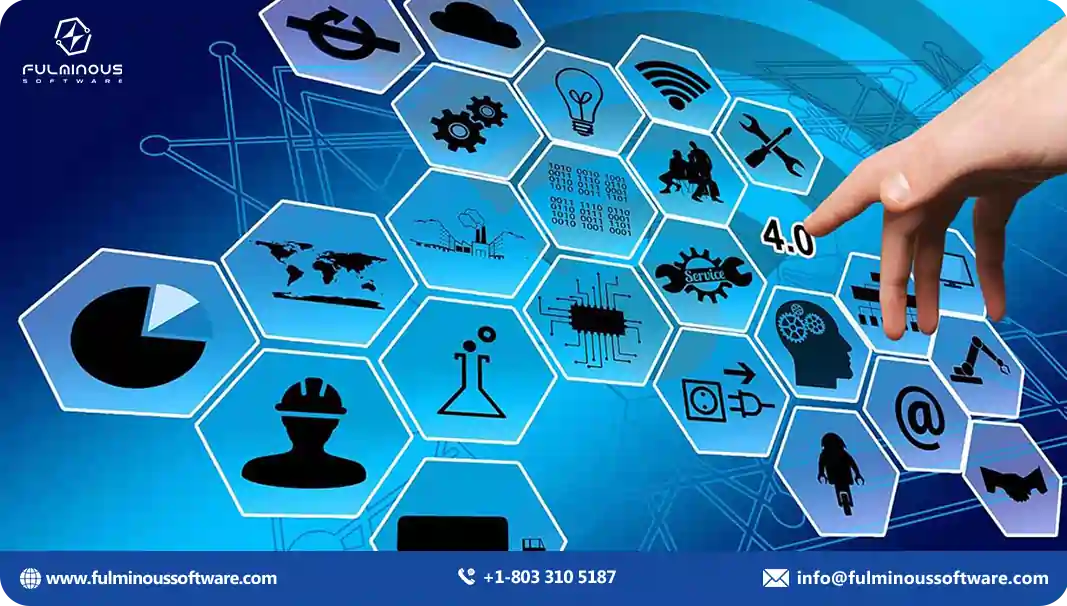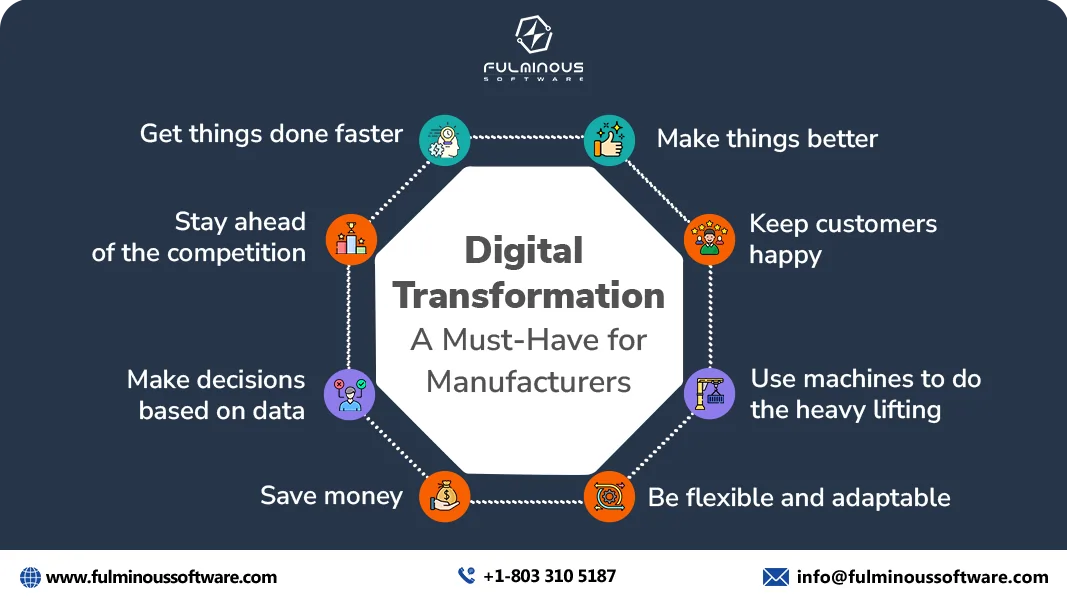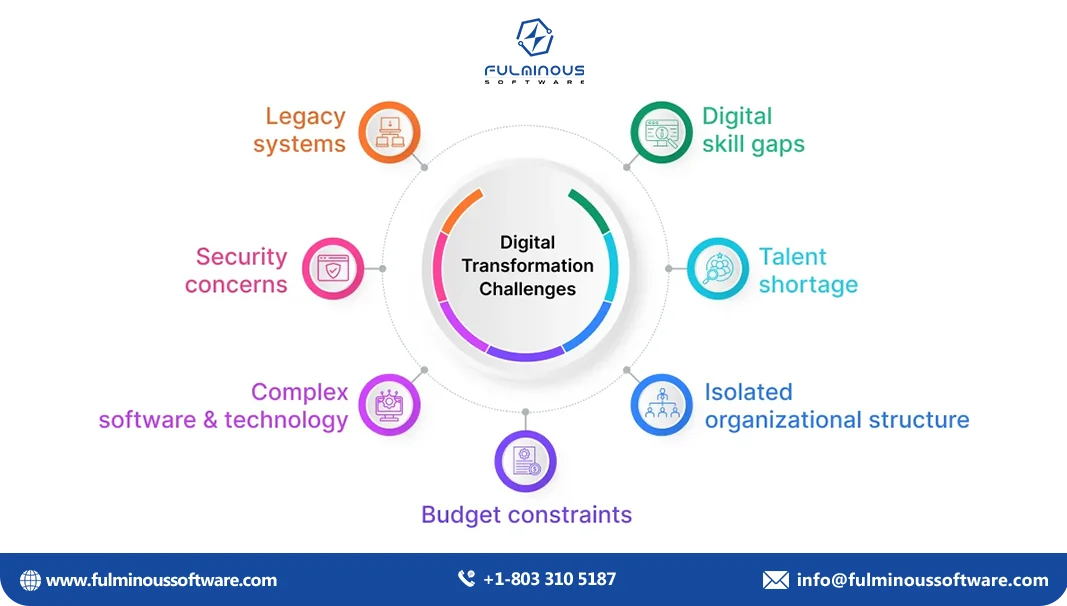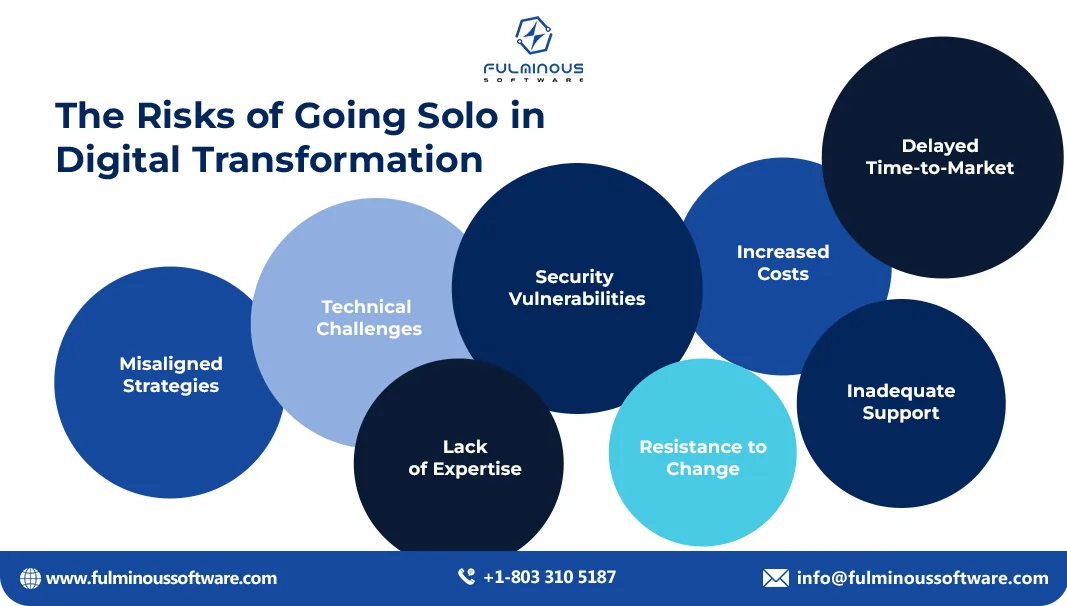Key Technologies for Digital Transformation in Manufacturing
Manish Kumawat
Last Updated on: 07 October 2025
Ever wondered how leading manufacturing businesses achieve their success? The answer is simple: they stay up-to-date in all dimensions—especially when it comes to adopting technologies for digital transformation. From automating processes to improving efficiency, these companies leverage the latest tech to stay ahead. When you compare your manufacturing firm with theirs, you may feel like you're running a factory with a setup from the early 1900s. Is it?
- Are you having to wait weeks for your machine to be repaired?
- Are your production lines experiencing frequent slowdowns due to manual processes?
- Is your ineffective inventory management making it difficult for you to meet client demands?
- Do you have to spend time and money on faulty products because of problems with quality control?
- Are you having trouble finding up-to-date information so you can make wise decisions?
- Do you have trouble predicting equipment malfunctions that cause unplanned downtimes?
- Are you unable to track your orders because the system was down?
If any of these sound familiar, then it's time to upgrade your game with trending technologies in digital transformation! When you see the amazing features of the latest technologies in the manufacturing industry, it will sound like a sci-fi movie. But, it's happening now.
Here we will discuss key technologies that are boosting the manufacturing industry, and their benefits with real-life examples.
Don't Get Left Behind: The Importance of Technology in Manufacturing

It's a fact that technology is changing day by day, including how it is useful in manufacturing. Manufacturing businesses that don't keep up with the latest trends risk getting left behind.
Think of it like this: if you're driving a car from the 1990s, you're going to have a hard time competing with someone driving a brand-new electric car. The same goes for manufacturing. If you're still using outdated equipment and processes, you're going to struggle to compete with companies that are using the latest technology.
Benefits of Knowing the Various Technologies in Digital Transformation
Understanding the different technologies that drive digital transformation in manufacturing can provide several advantages:
- Informed Decision-Making: Knowledge of various technologies enables you to make informed decisions about which ones are best suited to your specific needs and goals.
- Identify Opportunities: By being aware of emerging technologies, you can identify potential opportunities to improve your operations and gain a competitive edge.
- Effective Implementation: Understanding the capabilities and limitations of different technologies can help you plan and implement digital transformation initiatives more effectively.
- Risk Mitigation: Knowledge of potential risks and challenges associated with different technologies allows you to take proactive measures to mitigate them.
- Collaboration: Understanding the technologies involved in digital transformation can facilitate better collaboration with technology partners and vendors.
- Continuous Learning: Staying informed about the latest technological advancements ensures that your business remains competitive and adaptable to changing market conditions.

Choosing the Right Tech for Your Digital Transformation
As you know, so many technologies out there, that it can be confusing. But the reality is that choosing the right and best is essential. Otherwise, there will be a struggle to achieve the goal. How do you know which ones are right for your manufacturing business?
Here's a quick guide:
- Assess Your Needs: Once you know your goals, you can start narrowing down your tech options.
- Consider Your Budget: Digital transformation can be expensive. Be realistic about your budget and choose technologies that fit within your financial constraints.
- Evaluate Your Existing Infrastructure: What systems and software do you already have in place? Some technologies may be easier to integrate with your existing infrastructure than others.
- Don't Be Afraid to Experiment: Digital transformation is a journey, not a destination. Just try new things.
For Example: Let's say you're a small manufacturing company that wants to improve your quality control. You might consider implementing AI-powered vision systems. This technology is relatively affordable and can be easily integrated into your existing production line.
The key to successful digital transformation is to start small and gradually build on your successes. Don't try to do everything at once. Focus on the areas where you can see the biggest impact and build from there.
Remember: choosing the right and best technology for your business
Watch out for the Competitors: Learning from the Best

It is very useful to learn from those manufacturing businesses that are leading in your sector. Learning from their success and drawbacks can make your business more successful and you can reach ahead of them.
In the case of digital transformation, have a detailed study of the technologies they use. Here's how:
- Analyze their products: Take a close look at your competitors' products. What technologies they use to improve features do they have?
- Study their operations: Try to understand how your competitors are manufacturing their products. Are they using any new technologies?
- Monitor marketing: Watch out for their marketing campaigns. How are they reaching their customers with trending technologies?
Remember: Spying on your competitors isn't about copying them.
The Costs of Digital Transformation: A General Overview
Another major concern that comes into the mind of manufacturers is the huge cost of techs. But remember they are highly profitable investments.
The actual expenses will change based on things like how big your business is, which technology you use, and how much customization you need. A summary of some of the most important financial factors is provided below:
- Hardware and Software: This includes the cost of purchasing or renting necessary equipment, such as sensors, servers, and software platforms.
- Integration and Customization: Integrating new technologies with your existing systems may require custom development, which can add to costs.
- Personnel: Hiring or training employees to manage and maintain new technologies can be expensive.
- Data: It might take a lot of money and effort to gather, clean, and set up data for analysis.
- Maintenance and Updates: Ongoing maintenance and updates are essential to ensure the smooth operation of digital technologies.
It's important to note that while digital transformation can involve significant upfront costs, the long-term benefits can far outweigh the initial investment.
8 Trending Technologies for Your Manufacturing Digital Transformation
More than just having a manufacturing business website, you need to know more about the latest technologies in the manufacturing sector.
The Internet of Things (IoT): Your Factory's New Best Friend
Imagine your factory as a giant network of interconnected devices, each sharing information and working together to make things more efficient.
Think of it like a spy network inside your factory. Sensors and other devices are hooked up to machines, equipment, and even products, collecting data in real time.
Advantages
- Predictive Maintenance: Instead of waiting for machines to break down, IIoT can predict when they're about to fail.
- Process Optimization: IIoT data can help you identify bottlenecks and inefficiencies in your production process.
- Supply Chain Magic: IIoT can give you a clear picture of your supply chain, from raw materials to finished products.
Case Study: Foxconn Technology Group
Foxconn, the world’s largest electronics manufacturer, implemented IoT to monitor its vast production lines in real-time. By embedding sensors across machines, the company collected valuable data on machine health, enabling predictive maintenance and reducing unplanned downtimes by 20%.
This led to smoother operations and minimized losses due to faulty equipment. Additionally, the insights gained from IoT helped Foxconn optimize supply chains, resulting in better inventory management.
AI and ML: The Brains Behind Smarter Manufacturing
AI and ML are like super-smart assistants that can learn from experience. They can analyze data patterns, make predictions, and even automate tasks.
Advantages
- Automated Decisions: AI can help you make decisions faster and more accurately.
- Predictive Analytics: AI can help you predict future trends, like customer demand or equipment failures.
- Quality Control: AI can help you identify defects in products before they even leave the factory.
Case Study: Intel Corporation
Intel integrated AI and ML into its semiconductor manufacturing processes to enhance productivity and product quality. By using AI to analyze massive datasets from its production lines, Intel could predict equipment failures and address issues before they occurred, reducing downtime by 15%.
ML algorithms also optimized manufacturing workflows, improving yield rates by identifying inefficiencies and suggesting improvements. The result was a 25% reduction in defects and significant cost savings, allowing Intel to maintain its leadership position in the semiconductor industry.
Cloud Computing: Your Digital Factory in the Sky
Imagine having a factory that's always available, can grow or shrink as needed, and is protected from disasters. That's the power of cloud computing.
Advantages
- Scalability: Need more computing power? Just ask for it. Need less? No problem. Scaling up or down as needed is possible with cloud computing.
- Real-Time Data Access: Regardless of location, every member of your team has access to the same data.
- Disaster Recovery: If something bad happens to your factory, your data is safe in the cloud. Cloud providers have backup systems in place to protect your information.
Case Study: Johnson & Johnson
Johnson & Johnson used cloud computing to improve collaboration across its global manufacturing plants. The cloud allowed teams to access real-time data from anywhere, leading to better decision-making and faster responses to production issues.
By using the cloud, Johnson & Johnson could also scale its computing resources according to demand, reducing operational costs by 10%. Additionally, cloud-based data storage improved disaster recovery capabilities, ensuring that critical production data was always safe and accessible.
Big Data: The Hidden Goldmine in Your Factory
Imagine having a treasure filled with valuable information about your business. That's the power of big data.
Advantages
- Predict the Future: Predict future issues, spot patterns, and estimate client needs.
- Optimize Your Supply Chain: To increase productivity and cut expenses, analyze data from clients, logistical partners, and suppliers.
- Reduce Waste: Identify inefficiencies in your production process and find ways to make things more efficient.
Case Study: Samsung Electronics
Samsung Electronics embraced big data analytics to optimize its semiconductor manufacturing processes. The company collected vast amounts of data from its production lines and applied advanced analytics to uncover inefficiencies, optimize supply chains, and predict product demand.
By analyzing this data, Samsung was able to improve yield rates by 15%, reduce production costs, and enhance overall product quality. Big data also helped Samsung anticipate shifts in market demand, allowing it to adjust production schedules accordingly.
Robotics: Automation in Manufacturing
Imagine having a team of tireless workers who never get sick, never take breaks, and always do their jobs perfectly.
Advantages
- Increased Productivity: Without getting tired, Robots can work 24/7.
- Improved Quality: Robots can perform tasks with incredible precision, ensuring that your products are always top-notch.
- Worker Safety: Robots can handle dangerous or repetitive tasks, protecting your workers from harm.
Case Study: Volkswagen AG
Volkswagen implemented robotic automation in its assembly lines to increase efficiency and improve product quality. By utilizing AI-powered robots, Volkswagen reduced production errors by 20% and increased output by 15%.
Additionally, robots handle repetitive tasks, freeing up workers to focus on more complex activities. This not only improved production speed but also enhanced worker safety. The integration of robotics in Volkswagen’s manufacturing has been a game-changer, allowing the company to maintain high standards while reducing operational costs.
3D Printing: Building the Future, One Layer at a Time
The power of 3D printing is similar to being able to create a physical object from a digital blueprint. Using a laser or additional technologies, 3D printers construct objects layer by layer from a digital design.
Advantages
- Rapid Prototyping: Need to test a new design? 3D printing can create physical models in a matter of hours.
- Customization: Making a product that is exclusive to your clients might be facilitated by 3D printing.
- Reduced Waste: With 3D printing, you only use the material you need, reducing waste and saving money.
Case Study: Boeing Company
Boeing adopted 3D printing to accelerate the production of aircraft components, especially for custom parts. 3D printing enabled Boeing to rapidly prototype new designs, cutting down development time by 30%.
The ability to create complex geometries with 3D printing allowed Boeing to explore innovative designs that would have been challenging with traditional manufacturing methods.
Digital Twin: Your Virtual Factory
Imagine having a virtual copy of your factory that you can experiment with and test changes before they affect the real thing. That's the power of a digital twin.
Advantages
- Improved Design: Test new designs and processes in the digital world before they're even built. This helps you avoid costly mistakes and optimize your operations.
- Real-Time Monitoring: Keep an eye on your factory's performance in real-time, and predict potential problems before they happen.
- Cost Savings: You can save money and prevent costly errors by evaluating changes in a digital twin.
Case Study: Toyota Motor Corporation
Toyota used digital twin technology to build digital twins of its production facilities. By simulating processes in a digital environment, Toyota could test changes, optimize workflows, and identify potential problems before implementing them in real life.
This resulted in a 15% reduction in production errors and faster adoption of new techniques across its global plants. The digital twin also allowed Toyota to experiment with new manufacturing methods, improving efficiency and reducing costs.
AR and VR: Bringing the Digital World to Your Factory
Think of seeing digital data superimposed on the real environment with specialized glasses, or entering a virtual environment where 3D models are interactive.
Advantages
- Enhanced Training: AR and VR can create realistic training simulations, helping workers learn complex tasks without the risk of making mistakes.
- Remote Assistance: AR can be used to provide remote support to technicians, guiding them through repairs or maintenance.
- Design and Prototyping: VR can help designers visualize and test new products before they're even built.
Case Study: United Technologies Corporation (UTC)
United Technologies Corporation integrated AR and VR into its manufacturing processes to improve worker training and product development. Using AR, technicians were guided through complex assembly tasks with digital overlays, reducing errors by 15% and improving worker efficiency.
VR was used to simulate new product designs, allowing engineers to interact with 3D models before production began. This resulted in faster development cycles and reduced design errors.

The Consequences of Choosing the Wrong Technologies for Digital Transformation
Selecting the wrong technologies for your digital transformation journey can have significant consequences, including:
- Wasted Resources: Investing in technologies that don't align with your business goals or are not compatible with your existing systems can lead to wasted time, money, and effort.
- Delayed Time-to-Market: If your chosen technologies are not up to the task, it can delay your ability to launch new products or services, putting you at a competitive disadvantage.
- Operational Disruptions: Implementing incompatible or poorly integrated technologies can disrupt your day-to-day operations, leading to inefficiencies and decreased productivity.
- Security Risks: Outdated or poorly secured technologies can expose your business to cyber threats, putting your data and operations at risk.
- Reduced Return on Investment: If your digital transformation initiatives do not deliver the expected benefits, you may not see a return on your investment.
Remember: Choose the technologies wisely.
Why You Need a Digital Transformation Team
Doing the whole digital transformation process alone is like taking self-medication for chronic disease. Digital transformation with the help of a less experienced or normal software team is just like consulting a pediatrician for an old age-related disease.
Hiring a digital transformation team is vital for a successful process because it's a complex process that requires a lot of specialized knowledge and skills.
That's where a digital transformation team comes in. Here's why you need them:
- They know their stuff: These guys are experts in all things digital.
- They tailor solutions to your needs: No two businesses are the same. A digital transformation team will work with you to create a plan.
- They help you avoid pitfalls: They've seen it all before. From failed projects to security breaches, they know how to keep you on the right track.
- They're your partners in success: A good digital transformation team will work closely with you, providing guidance and support every step of the way.
Get a digital transformation team on your side. They'll help you make the most of technology and achieve your goals.

Conclusion
Digital transformation with various technologies is changing the way we make things. but it is necessary to know about the right and best technologies before investing in digital transformation. By using cool tech like the Internet of Things (IoT), Artificial Intelligence (AI), robots, and many more, you can make things faster, cheaper, and better.
As each technology has its own advantages and uses, you need a deep study. Digital transformation consultation services of Fulminous Software will help select the ideal techs. Talk to us at Fulminous Software. We're the experts in helping manufacturers like you make the most of digital transformation.
Don't wait! The future of manufacturing is here, and it's time to join the party. Contact us today.
FAQs
- Q1: What is digital transformation in manufacturing?
- A: Digital transformation in manufacturing involves adopting advanced technologies to improve processes, increase efficiency, and enhance product quality.
- Q2: Why is IoT important for manufacturers?
- A: IoT enables real-time data collection, predictive maintenance, and optimized processes, reducing downtime and enhancing overall operational efficiency.
- Q3: How does AI benefit manufacturing businesses?
- A: AI enhances production efficiency, automates routine tasks, and provides predictive analytics to reduce waste and improve decision-making.
- Q4: What is predictive maintenance in manufacturing?
- A: Predictive maintenance uses data and analytics to foresee equipment failures, helping manufacturers prevent downtime and extend machine life.
- Q5: What role does cloud computing play in manufacturing?
- A: Cloud computing facilitates scalable storage, real-time collaboration, and seamless data access, boosting agility and reducing IT costs.
- Q6: How does 3D printing benefit manufacturers?
- A: 3D printing allows manufacturers to create prototypes quickly, reduce material waste, and offer customizable solutions with shorter production cycles.
- Q7: What are the benefits of using digital twins in manufacturing?
- A: Digital twins simulate real-world processes, allowing manufacturers to test scenarios, optimize operations, and enhance product quality.
- Q8: What challenges do manufacturers face during digital transformation?
- A: Manufacturers may encounter resistance to change, high implementation costs, and the need for skilled personnel to manage new technologies.
HIRE A TOP SOFTWARE DEVELOPMENT COMPANY

 Verified
Expert in Software & Web App Engineering
Verified
Expert in Software & Web App Engineering
I am Manish Kumawat, co-founder of Fulminous Software, a top leading customized software design and development company with a global presence in the USA, Australia, UK, and Europe. Over the last 10+ years, I am designing and developing web applications, e-commerce online stores, and software solutions custom tailored according to business industries needs. Being an experienced entrepreneur and research professional my main vision is to enlighten business owners, and worldwide audiences to provide in-depth IT sector knowledge with latest IT trends to grow businesses online.
Partner with Top-Notch Web Application Development Company!
Discuss your Custom Application Requirements on info@fulminoussoftware.com or call us on +1-903 488 7170.
15 Days Risk-Free TrialRecommended Articles


